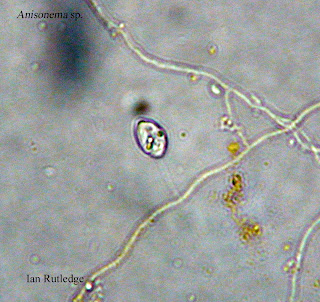Today we set up our aquariums and began to observe some of the activities taking place within them!
My aquarium was filled with water from the 7th site, Third-Creek in Tyson Park (Knoxville Co. Knoxville TN Partial shade exposure. N30 57 13.53 W83 56 32.37 824 ft. 10/14/2013) (McFarland 2013).
As seen in the above picture I filled the bottom of the aquarium with about 1/2cm of sediment, and then took the water from just above the sediment in the collected sample, and transferred it to make up around 2/3 of the water. Finally, I filled the last 1/3 of my aquarium with surface water from Dr. McFarland's collected sample from Third Creek in Tyson Park.
In addition to the water and sediment from Third Creek, my aquarium has two different types of mosses, and a carnivorous plant included in it's system.
The first moss is:
Amblestegium varium (Hedwig) Lindberg. Moss. Collection from: Natural spring. at Carters Mil Park, Carter Mill Road, Knox Co. TN. Partial shade exposure. N36 01.168 W83 42.832. 10/13/2013 (McFarland 2013).
The second moss is:
Fontinalis sp. Moss. Collected from: Holston River along John Sevier Hwy under I 40 Bridge Partial shade exposure Holston River water Shed N36 00.527 W83 49.549 823ft 10/13/2013 (McFarland 2013).
The carnivorous plant is:
Utricularia gibba L.
Flowering plant. A carnivorous plant. Original material from south shore of Spain Lake (N 35o53 12.35" W088o20' 47.00), Camp Bella Air Rd. East of Sparta TN. in White Co. and grown in water tanks outside of greenhouse at Hesler Biology Building. The University of Tennessee. Knox Co. Knoxville, TN. 10/13/2013 (McFarland 2013).
The first moss,
Amblestegium varium (Hedwig) Lindberg, can be identified as dark green color, while the second moss,
Fontinalis sp., can be identified as a very dark reddish brown color. The carnivorous plant,
Utricularia gibba L. is identified as being a light green with little black dots spread throughout the structure of the plant. These dots are dead flowers and will eventually be replaced with new growth. All three can be seen in the above picture of my aquarium (McFarland 2013).
Observations:
I was fortunate enough to observe my aquarium on the digital microscope during the very first observation session and got some really cool images and videos from it. Here are some of the pictures:
Picture 1. Unidentified Nematode moving violently.
Picture 2. Unidentified Nematode moving violently.
Picture 3. Unidentified organism moving violently.
Picture 4. Unidentified organism moving violently.
I also got a few videos of activities:
and:















